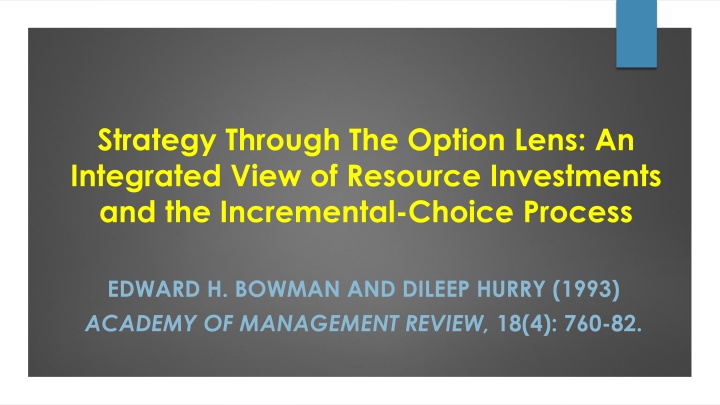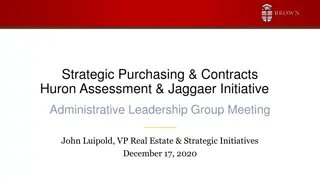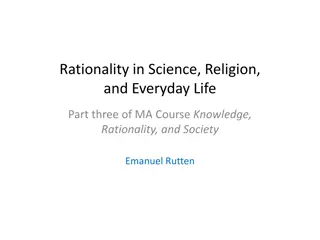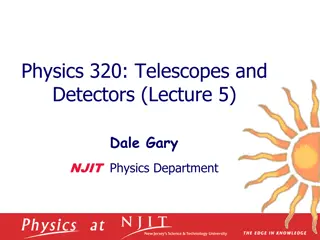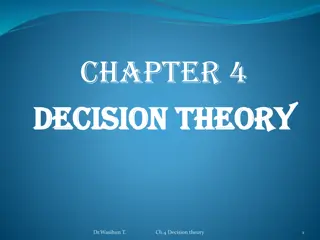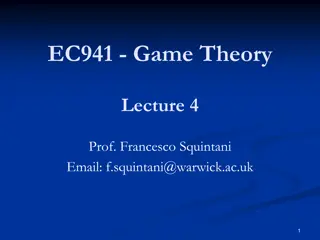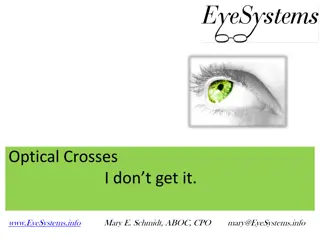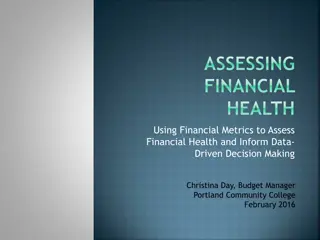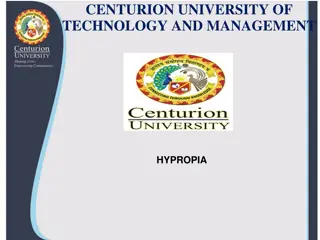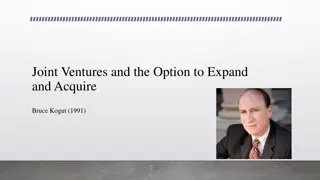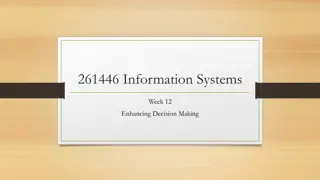Enhancing Strategic Decision-Making Through Real Options Lens
Strategy development is viewed through the real options lens, emphasizing the integrated view of resource investments and the incremental choice process. It explores how organizational resources generate strategic options for future decisions, the concept of shadow options, and the value of incremental strategy within the option chain framework.
Download Presentation

Please find below an Image/Link to download the presentation.
The content on the website is provided AS IS for your information and personal use only. It may not be sold, licensed, or shared on other websites without obtaining consent from the author.If you encounter any issues during the download, it is possible that the publisher has removed the file from their server.
You are allowed to download the files provided on this website for personal or commercial use, subject to the condition that they are used lawfully. All files are the property of their respective owners.
The content on the website is provided AS IS for your information and personal use only. It may not be sold, licensed, or shared on other websites without obtaining consent from the author.
E N D
Presentation Transcript
Strategy Through The Option Lens: An Integrated View of Resource Investments and the Incremental-Choice Process EDWARD H. BOWMAN AND DILEEP HURRY (1993) ACADEMY OF MANAGEMENT REVIEW, 18(4): 760-82.
Motivation Strategy emerges from organizational resources and unfolds over time in different ways generating further resources. During the process, there is an interplay of Between resources and choices Between investment and growth opportunities Among organizational learning, investment size, and investment timings
Option Theory Option theory originated in the intuitive belief of keeping option open . Current option theory has roots in financial economics. Both Option theory and strategic management study organizational investments One in terms of economic value, and The other in terms of action and performance.
Strategy through the Real Options Lens Resources and the bundle of real options: Organization s resources give rise to a bundle of real options for future strategic choice. These bundle of real options arise: when existing resources and capabilities allow preferential access to future opportunities. - example of a potentially friendly bidder from a joint venture from accumulating learning and capabilities - the sunk cost of existing assets works like an option contract in limiting downside risk. Organizational slack also constitute a repository of options.
Strategy through the Real Options Lens Shadow Options and Sense Making: Opportunities for strategic choice come into being only when recognized by decision makers. Options awaiting recognition = shadow options Managers must make sense of organizational actions and resources before they can recognize shadow options. Organizations define/create their own realities, given their history, knowledge, and routines.
Strategy through the Real Options Lens Incremental Strategy and the Option Chain When an option is struck, the resulting configuration of resources will, in turn, yield new options for future exercise. Strategies are produced/emerge by the sequential striking of this option chain. Strategy emerge because of linked decisions based on both cognitive (recognition) and economic logic. Resulting further in shadow options or sequential investments. Strategies unfold in two ways depending on whether their options are: Incremental: simple calls and puts Flexibility: i.e. alternate investment option Strategic change can occur. For example Investing in alternate technology
The Activation of Real Options A fixed sequence of actions in involved in the activation of options. Upon recognition of a shadow option, managers are motivated to convert it into a real option by securing preferential access waiting to see if the opportunity materializes developing the skills needed to exploit it fully Given uncertainty, usually this involves making a small investment rather than a large one When the opportunity materializes, and the org is ready to exploit it, the option will be struck with the managers making a larger investment. Investment is necessary for the option to be fully activated.
Theoretical Refinements and Research Propositions Downside Risk and Optimal Inertia Organization investment behavior has an element of inertia = sunk costs (i.e., in existing investments) creates pressure on the org to defer new investments The range between minimum anticipated profit and maximum loss before a firm decides to invest = zone of optimal inertia The more protection an organization has against downside risk, the wider its zone of optimal inertia Proposition 1: Organizations with better developed bundles of options will expand more aggressively in growing markets and economic upturns, and persist longer in difficult markets and economic downturns, than competitors with less developed option bundles
Theoretical Refinements and Research Propositions Perceived Environmental Uncertainty The value of an option increases as the volatility of the underlying asset s value increases Conversely, as volatility decreases, the organization stands to gain more by striking Managers are motivated to strike options when environmental uncertainty is low Environmental volatility is often a function of time for exogenous reason (the velocity of changes in opportunities) and endogenous reasons related to the speed of organizational learning Proposition 2: Given realistic perceptions of environmental uncertainty, organizations that hold options during unstable periods and strike options in stable periods will show superior long-term growth and profit performance compared to organizations exhibiting other types of investment behavior.
Theoretical Refinements and Research Propositions The size and timing of organizational investments It is valuable to make small investments in options, followed by large investments in option strikes In new markets, new businesses, and new technologies, orgs are likely to be most effective when they use small investments to develop capabilities, then build on these investments by linking large investments to deploy capabilities. Successful organizations progress from learning investments to full operations in a manner resembling an option chain Proposition 3: Organizations that enter new business and markets by linking investments so that small options are followed by large strikes will perform better than those entering with only discrete small, or large, investments.
Theoretical Refinements and Research Propositions Generally, it is optimal to hold a call unexercised until it expires, but early strikes may be optimal for puts and calls on income-producing assets. Two signals to strike are particularly important: Signal indicating the arrival of the opportunity incentive to wait still exists Expiration signal (e.g., threat of preemption by a competitor) Managers are less likely to miss the expiration signal because The option goes to waste they tend to perceive threats more accurately than opportunities. Proposition 4: Effect of investment timing on performance of organizational investment in option strikes ((a) = high performance to (e) = low performance): (a) Calls struck after receiving both signals (b) Puts struck after receiving only the opportunity arrival signal. (c) Calls struck after receiving only the opportunity-arrival signal. (d) Calls and puts struck after receiving only the expiration signal. (e) Calls and puts struck before receiving either signal.
Theoretical Refinements and Research Propositions The portfolio of options An organization s ability to strike options effectively is also influenced by its structure If the org s structure allows individual options at the business and functional levels of operations to be struck independently, the bundle approximates a portfolio of options . If it is possible for a single decision at the top of the hierarchy to summarily dispose of a business (and the several options embedded in its assets) the bundle is closer to an option on a portfolio of assets. In general, it is more valuable to hold a portfolio of options Networks, keiretsu operate like a portfolio of options, whereas the M-form today approximate an option on a portfolio of assets. Proposition 5: Organizations with structures that are capable of holding a portfolio of options will show wider diversification, with fewer divestitures, than organizations with structures that restrict choices to an option on a portfolio of assets
Contribution to Strategy and Organization Theory Resource allocation + Strategic positioning - economic content theories assuming rational decision making Sense making + Learning = behavioral process theories assuming naturally emergent decision making Positioning + Leaning = future oriented analysis The option lens integrates these themes through the view that organizational investments both (1) provide current returns and cash flow and (2) open-up options. Thus, a firm s market value = earnings generated by current investments + option value of future strategic choices The option bundle strengthens the conceptual bridge between strategic action and the value of the firm The economic rationale of the option value may capture the heart of managerial intuition re: org investments The recognition of shadow options is the mechanism by which learning continuously translates into strategy choices. Options form the inimitable resources that give an org its sustained performance and competitive advantage.
A New Type of Explanation for Empirical Findings Strategy and selection: Deterministic descriptions of selection (population ecology) and the proactive and adaption approaches of strategy both do not incorporate the perpetually tentative and exploratory nature of investments, so miss the possibility that performance is the quasi-fortuitous byproduct of their lagged interaction with the environment. The garbage can: The garbage can description of solutions existing in advance of problems is consistent with the view that prior resource investments create future strategic options. Means consensus: Orgs whose managers agree on the means of their strategies outperform orgs that show consensus on their goals; means consensus implies agreement on the distinct investment streams to be followed (the options to be held). The risk-return paradox: There is a negative correlation between firms profitability and the variability of profits managers will tend to retain less profitable investments for their option value in times marked by high variability of profits and will make more profitable investments when performance variability is reduced.
